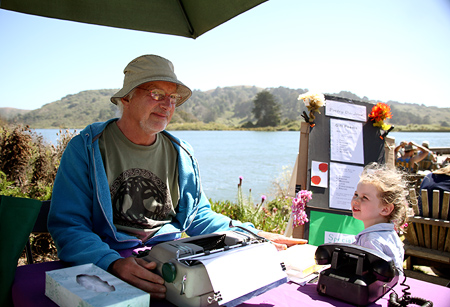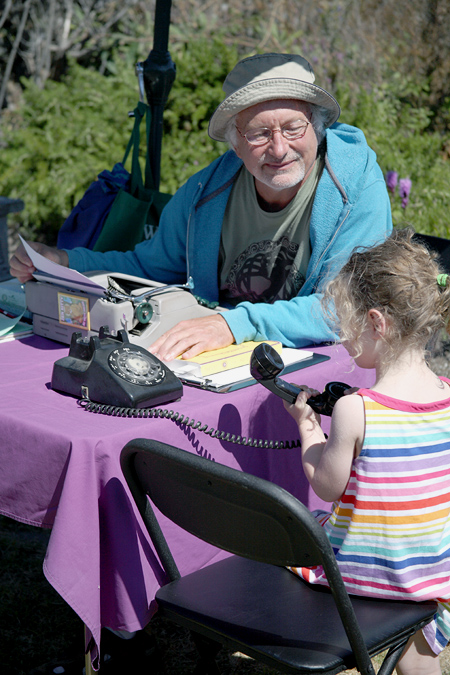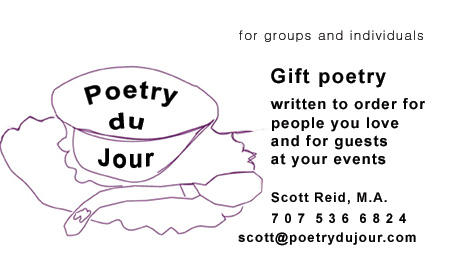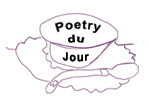Poetry du Jour Blog
Honey-Jelly
and the Green Parrot
of South Pasadena
16 July 2017

Norah sharing her secret honey-jelly recipe with me.
Calling Grandma
I have already spilled my coffee on the tablecloth. My sun umbrella, caught in a slight puff of wind skirting from the ocean, topples, nearly slicing a young nursing mother from her infant on the lawn at Café Aquatica. This promises to be a great day writing poems for travelers here in Jenner on a sweltering Sunday.
I'm fidgety. Getting the table set up properly is a challenge. Using carbon paper between quality bond paper and a plain sheet (I keep the carbon copy), I try to place the carbon in between, but the wind keeps yanking everything everywhere. A second toddler arrives and begins tugging on the pink ribbons attached to my sign. What else could go wrong?
"I haven't seen a manual typewriter since college," a lady in blue flower shoes and brown hair says from a few feet away.
While I am interviewing her, a family of four come and sit down on the Adirondack chairs nearby. They listen to my questions. "What does your husband like? What are his dislikes? What fragrance do you associate with him?" I ask, jotting notes as she speaks. When she steps away, and I begin to type, I turn toward the family and offer to write a poem for them.
Ten minutes later, I hand the poem to the lady in blue flower shoes. She's delighted. By far the most interesting and delightful visitors to the Poetry du Jour table today are children.
The young girl of about 10, with her sister visiting Sonoma County from San Diego, seems interested. I ask her and her family if they are enjoying the relaxing cool. "How much does the poem cost?" the father wants to know. We settle on price, and I begin to interview his eldest daughter, Madeline.
A shorter poem for children consists of three parts: a beginning, a middle, and an end, or, as in mythology, the beginnings of a life, the present time, and the future, including a wish for something in the future, the subjunctive.
Madeline’s poem today is dedicated to her grandmother Eleanor in Pasadena. I ask her, “What kinds of animals or birds does Eleanor like?” Madeline says, “Parrots.” I ask her what color, and she says green parrots. "Where does the parrot live? What does she love to do?" I want to know. An action verb. I’m hoping for an action verb.
But for some reason, verbs are difficult to come by. After a few prompts, and with her mother’s help, I learn that Eleanor loves to play piano and dance. I also learn that grandma loves to make tacos at home. The first stanza pretty much writes itself.
Grandmother Tree
Once you were
a green parrot
in South Pasadena,
playing piano,
dancing around
fragrant tacos
in your kitchen
turning light
into itself.
We finish the poem in about fifteen minutes, and the time arrives to read the poem to Eleanor in Pasadena. Madeline's mom and dad and little sister are at the table now. I pick up the rotary telephone and dial Pasadena. "Hello, Eleanor?" I say. "Hello, this is Scott, calling from Jenner ... Yes, a lovely cool afternoon out here on the coast ... I understand that you are fond of parrots ... How'd I know? Madeline told me ... Hang on ... She's right here."
"Your grandmother is on the phone," I say, handing the phone to the
little girl. "She'd love to hear your poem." She places the phone to her
ear and begins to read it with her family listening.
During the time that Eleanor in South Pasadena "hears" Madeline's poem, a young
mother with her daughter have kneeled on the grass nearby.
They're listening in. The baby girl has blonde hair, curly as a sea cucumber. Blue eyes.
After Madeline finishes reading, the young mother and her baby
daughter join me at the table. We begin to write a similar poem.
Three-years-old, daughter Norah is sitting on mom's lap. A young couple visiting from San
Francisco, dad is sitting over by the cafe window with his newborn in a
carrying basket. I hear Norah say the word "bumblebee," and instantly
the poem begins buzzing around our table, lifting Norah's
hair as it passes by her forehead.
The poem is dedicated to Norah's grandmother, Nancy, whom I learn likes
to make "honey-jelly" over by the kayaks moored beside the boat launch.
The family is on their way home from visiting grandma in Sea Ranch, and I ask Norah to tell
me who is the honey-jelly for. Norah tells me that "Nancy gives it to
the other bees." I'm wondering, "Where do they live?" With a little help
from mom, I learn that the bumblebee family lives in Bodega Bay. The
bees write the first stanza of the poem.
In a moment, Norah's father steps over. He's circling the table, taking
pictures. I ask him if he would be OK with taking a few pictures of me
and his daughter using my camera. He unzips my DSLR from its carrying
case, attaches the flash, and begins popping shots, spinning the
aperture and shutter dials like a pro.
Having finished my interview with Norah, I begin typing up the poem.
Telephone handsets were made in those days for adult hands, and so it
is a delight to see a tiny hand holding the receiver. Norah
pretends to call Grandmother Nancy, but she hasn't yet learned to read.
What is magical about this interchange with Norah and with Madeline, is the
way both families become involved. Madeline's family became involved by
helping her to come up with answers to the prompts; Norah's family became
involved when her father began taking pictures, circling the table, watching
the swirling hive of honey-jelly spinners make a poem. A poem from the wings
of the most creative bee herself, Norah.
Norah loves the sound of the typewriter. She's enchanted with the idea that
words can come from a machine clackety-clacking with the whiz of bee's
wings. She wants to try it herself. I put a sheet in the roll and turn the Smith Corona toward
her. She begins to hunt and peck. "Can you find the
letter N?" her father asks. Norah's tiny index finger, the size of a thistle, roams
across the keys. When she finds it, she presses lightly and holds. The typebar stumbles on the platen. Several smudgy tries later, the letters n-o-r-a-h
appear on the paper.
I take a break and walk across the parking lot to check up on the bees over by the kayaks.
A family of bees. I learn today how poetry draws families together. Both granddaughters Madeline and Norah choose
to write poems for their grandmothers. During the writing AND reading process, both families are engaged. Poetry speaks to us from
ancient times, when families drew together to share mythologies, invocations, praises, and blessings in poetry. I decide to call it a day.
It's been fun.
When I come back around the corner to collect my table,
typewriter, phone, and pots of honey, a very handsome man with round features and
wearing a blue shirt is standing in front of my table, looking at
my sign. He's holding the hand of a very young girl who watches me suspiciously.
She's wearing an oversized white sweater and pink sandals. "Do
you speak German?" he asks.
I am available via Skype for consultation. Please email me to order your gift poem today.
Bumblebees
Once you were
a bumblebee
making honey-jelly
beside the kayaks,
giving it to me
and the other bumblebees
at Bodega Bay.

Norah calling grandmother on the phone.

